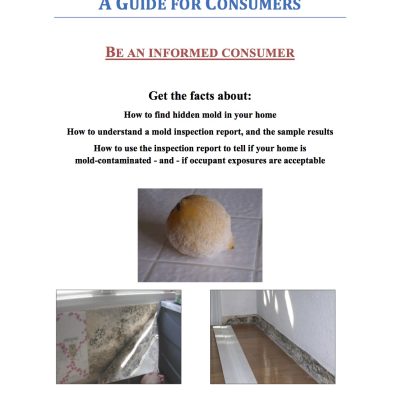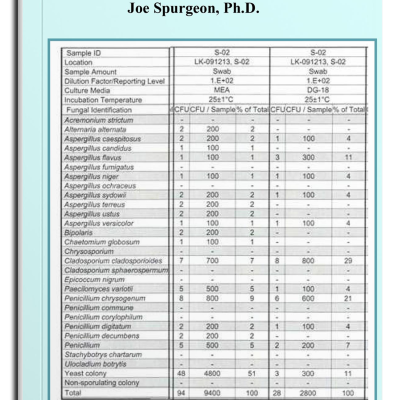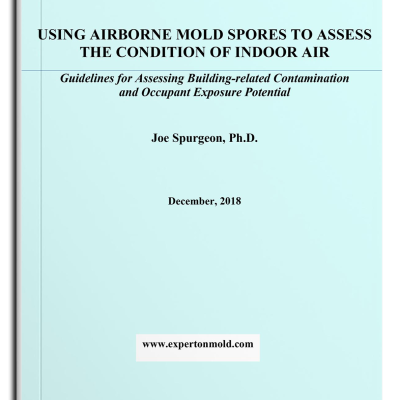The Mold Inspection Process
- Phases in a Mold Inspection
The typical mold inspection may be thought of as consisting of three separate phases, as follows:
- Phase 1: an initial screening inspection to determine if evidence of a water intrusion problem can be detected (Site Inspection, Incident History, Occupant Interview, Walk-Through and Visual Inspection).
- Phase 2: a more thorough assessment of Building-Related Contamination (HVAC Inspection, Sampling Plan, Sample Collection).
- Phase 3: assessment of Occupant Exposure Potential if adverse health effects may be a potential issue.
The first two phases are typically performed during a mold inspection. However, if the homeowner is not sure a problem exists, they may choose to limit the initial inspection to a Phase 1 screening inspection. Separating the inspection into phases is a cost-effective approach for limiting the initial cost of a mold inspection, yet the homeowner has some assurance that a mold problem is not affecting their living space.
- Type of Inspection
The homeowner or other stakeholder may have a variety of concerns related to water intrusion, and a mold inspection may have the objective of answering multiple questions. The following types of mold inspections are commonly performed, and each has a different objective:
- Escrow (purchasing a property),
- Screening (Phase 1; determine if a mold problem may exist),
- Baseline (periodic, pro-active, often commercial buildings),
- Preventive (organ transplant patient coming home),
- Incident (Phase 2 & 3; water intrusion event has occurred),
- Post-remediation Evaluation or Verification (following a mold remediation).
- Types of Materials
Fungal contamination shall be defined as the detection of fungal spores on a surface [table, chair cushion, etc.] without detecting evidence that fungal growth has occurred. Since mold follows moisture, mold will typically not grow on items or surfaces that have not been wet. However, mold spores that have become airborne will eventually fall out of the air, settling on furniture, clothing, and horizontal surfaces in areas adjacent to the site of water damage. When this occurs, it is simple contamination. Unless the occupant is especially sensitive to mold, it would be expected that these items can often be cleaned and placed back in service.
Contaminated items may represent a substantial exposure hazard to the occupants. During one inspection I wanted to determine (1) if furniture in a room adjacent to the site of the water intrusion had been contaminated, and (2) demonstrate the potential for occupant exposure from the contamination (legal case). The living room had not been affected by the water intrusion, so I collected an airborne sample next to the couch (quiescent sampling). Only a moderate amount of mold spores were detected in the initial sample. Then (wearing a respirator), I repeatedly smacked the cushions with my hands (aggressive sampling), waited a few minutes, and collected a second airborne sample. The second sample contained more than 300,000 spores per cubic meter, a very high concentration. In this instance, the contamination was so substantial that the furniture was discarded.
[Note: a tape lift sample, swab sample, or micro-vacuum sample (increasing order of personal preference) would typically be collected from the surface of the cushions, but I also needed to demonstrate occupant exposure]
Fungal colonization is the detection of actual fungal growth on or within a porous or semi-porous material. Mold growing within a porous material tends to wrap itself around the threads or fibers, making it almost impossible to effectively clean the item. Colonized materials typically cannot be cleaned and are generally discarded.
[Note: “differential sampling” may be used to determine if a porous, soft-surface material is contaminated or colonized. This sampling method is not used very often but is available if needed. Reference: The Collection and Interpretation of Indoor Mold Samples: A Comparison of Methods; Joe C. Spurgeon, Ph.D.; www.expertonmold.com]
Materials may be categorized as porous, semi-porous, or nonporous. Examples of these categories include:
- Porous: fabric, cloth, paper, drywall, foam cushions,
- Semi-porous: particle board, plywood, oriented strand board (OSB),
- Nonporous: metal, glass, plaster, hard wood.
These categories separate surfaces, materials, and contents according to their potential for contamination, colonization, and remediation. Porous and semi-porous materials are subject to both contamination and colonization, while nonporous materials are generally only subject to contamination. However, the varnish on hardwood furniture will support mold growth (colonization). Second, different sample collection methods may be used for each type of surface. For example, a tape lift sample may be collected from a nonporous surface, a swab sample from a semi-porous surface, and a micro-vacuum sample from a porous surface.
- Possible Outcomes of an Inspection
The statements that the “condition of the building was acceptable” and that the “assessment of the building was acceptable” have different meanings. The product of a mold inspection is an “assessment”, which shall be defined as “the structured, systematic evaluation of the subject space for the presence of a contaminant of concern”. Both the condition of the building structure and the potential for occupant exposure should be assessed separately; and the resulting assessment has three possible outcomes, as follows:
- Assessment is acceptable
- Assessment is unacceptable
- Assessment is uncertain
- Option 1: Assume assessment is unacceptable, or
- Option 2: Collect additional samples until assessment is known.
If the assessment is “acceptable”, then the inspection did not detect evidence of a water intrusion, visible mold, hidden mold, or unusual types or amounts of mold spores in the indoor environment; and the inspection process is finished. If the assessment is “unacceptable”, then the inspection did find that one or more of these factors were affecting the indoor environment; and the inspection process is also finished. Even when the assessment is unacceptable based on the visual inspection, I recommend collecting airborne samples to assess occupant exposures.
However, hidden mold is often difficult to find because by definition it is hidden from view. In addition, an inexperienced inspector may make the mistake of finding one contaminated site and then stop looking for additional amplification sites. Second, a residential mold inspection often involves the collection of a limited number of samples. In my opinion, detecting mold is a “numbers game” – the more samples collected, the higher the cost of the inspection, but the better the chance of detecting mold contamination. As a broad generalization, I would prefer to collect ten $40 samples rather than one $400 sample (but use common sense, sometimes a $400 sample can be the better option).
For these reasons, it’s not unusual for a mold inspection to result in an assessment of “uncertain” (welcome to the real world). When this happens, the homeowner has two options. The first option is to assume that since no issues were proven to exist, nothing more needs to be done. This response is often adopted by a reluctant spouse or a landlord. The second option is to acknowledge that the initial concerns of the homeowner have not been completely resolved. Health sciences are conservative in nature. This means that conceptually, since human health and safety may be involved, if the assessment is “uncertain”, then conditions are assumed to be unacceptable until they can be shown to be acceptable.
Unfortunately, in a practical sense, the word “conceptually” in the above paragraph translates as meaning “unlimited funds”. A practical approach, and what may be the correct approach, is to regard the results of a mold inspection as just one piece in a larger puzzle. The results of even a limited screening inspection (performed by a qualified professional) afford some assurances that at least a major problem is not affecting the home. Do any occupants have symptoms consistent with exposure to a microbial contaminant or allergen? If not, there is an even greater assurance that a major problem does not exist. In this instance, the homeowner may decide to wait and see if their initial concerns are eventually resolved. If some family members do have symptoms, then the assumption that conditions may be “unacceptable” would be prudent; and a more thorough inspection, and the collection of additional samples, may be appropriate.





